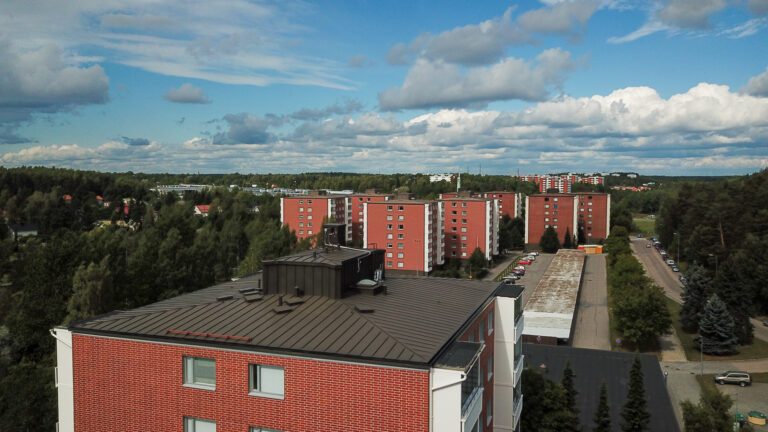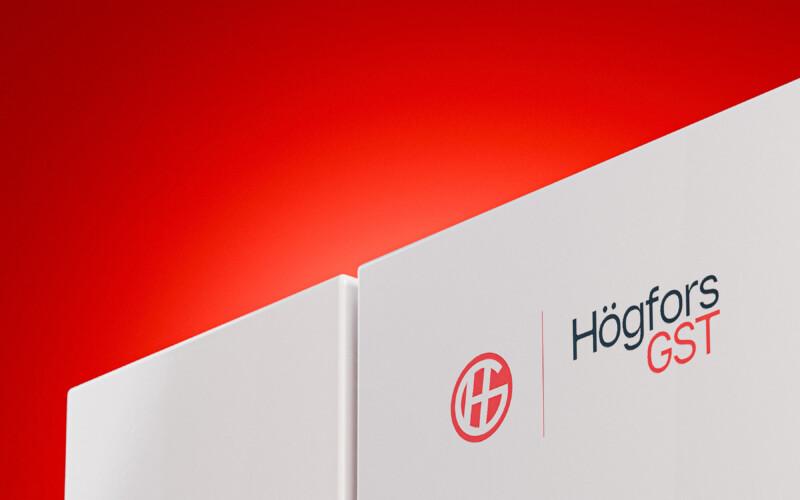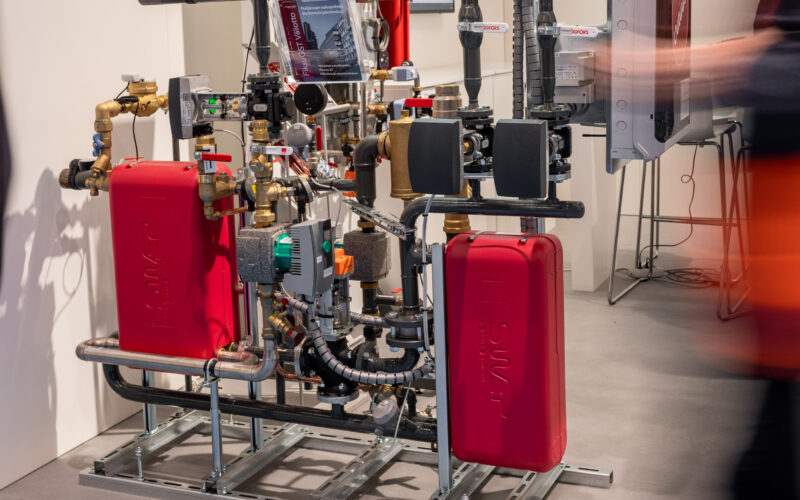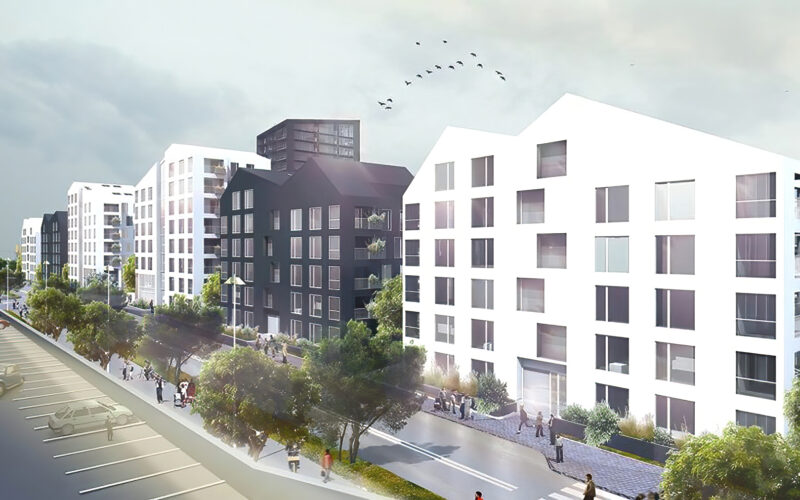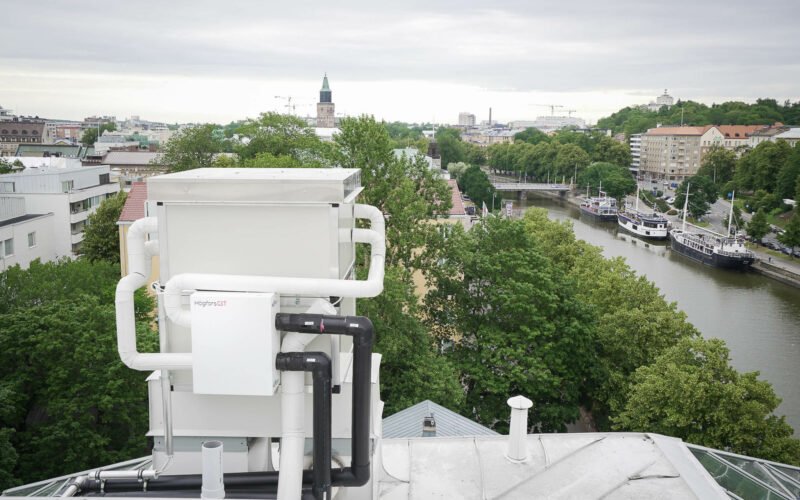A heat recovery project is extensive and comprehensively impacts property technology. It usually affects the hot water, heating, ventilation, and electrical systems. Due to its comprehensive nature, it should be well prepared with experts. We put together a series of questions and answers to frequently asked questions in heat recovery projects. Click on the questions to read more!
WHAT KIND OF BUILDINGS ARE SUITABLE FOR HEAT RECOVERY?
The property must have hot-water heat distribution and mechanical exhaust ventilation.
WHAT KIND OF PROPERTIES SHOULD A HEAT RECOVERY SYSTEM BE INSTALLED TO?
This must be assessed on a site-by-site basis by making estimates and then making a decision as to whether the site’s savings potential is sufficient for the system.
Generally, the most profitable energy saving projects are in properties with high consumption. On the other hand, the price of heating energy will continue to rise in the future, so it is worth installing heat recovery in smaller properties as well.
DOES IT MATTER HOW MANY SEPARATE BUILDINGS THERE ARE?
Technically, the heat recovery system can be implemented even if the property consists of several apartment buildings and the heat distribution room is located in only one of them. The exhaust fan or fans can be located on the roof, in the fan room or in the attic.
WHAT SHOULD I CONSIDER BEFORE PROJECT PLANNING?
Right from the start, it is a good idea to contact the property manager and map out the existing technical documentation for the property. This will significantly help future steps in the project.
During the project planning phase, one good channel is to contact the Real Estate Association and ask for support and advice on completing such projects. They also provide good information on various forms of contracts, controls, and other practical examples.
WHO IS RESPONSIBLE FOR THE FUNCTIONING OF THE SYSTEM?
The heat recovery system should be treated as a single unit, combining different sources of heat, heat distribution, hot water and ventilation. Therefore, it is important to understand that the management of such an entity also requires a control system. It is important to find a system vendor capable of delivering such a device, the system vendor will then be responsible for the device it manufactures. If you try to assemble the heat recovery system from different devices without a control system, the end result will be confusing and the responsibilities will be divided.
HOW DO ENERGY COMPANIES FEEL ABOUT HEAT RECOVERY?
If your property has district heating, you should contact your energy company early in the project. Then they can guide and tell you the requirements of district heating technology for heating your property. Generally speaking, energy companies have a positive attitude towards heat recovery as long as it is well implemented and compliant with regulations.
HOW DO I COMPARE DIFFERENT HEAT RECOVERY SOLUTIONS?
The annual ventilation efficiency and SFP values can be used to effectively compare different solutions. These methods are standard and their calculation methods are defined in the building codes. The heat recovery system has many electricity consuming components and their consumption should be as low as possible in relation to the amount of heating energy produced.
WHAT IS THE ANNUAL EFFICIENCY OF THE EXHAUST AIR HEAT RECOVERY?
The annual efficiency of the exhaust air should be as high as possible. In new buildings, it must be 45%. This means that the amount of air that needs to be “recycled” from the air exiting the house to heating the property on an annual basis is at least 45%.
The efficiency is calculated by the formula (indoor temperature minus outflow temperature) / (indoor temperature minus outdoor temperature). With an efficient heat recovery cell and a heat pump optimized for heat recovery operation, the outlet temperature during the heating season is approximately + 2C … + 4C. Thus, the efficiency of the exhaust air is even more than 100% with an outdoor temperature higher than this. The annual efficiency of exhaust air is 90%… 105%… in southern Finland and 75%… 90% in northern Finland
The temperature of the blown air is only + 2C … + 4C with a sufficiently efficient cell. If the cell is not efficient enough, the temperature of the exhaust air will be higher, which will clearly reduce the annual efficiency of the exhaust air and, of course, the heat output of the system.
Thus, the annual efficiency of the exhaust air is clearly better compared to traditional heat recovery units when the system is properly dimensioned and the equipment used is optimized for the system. So it can be said that ventilation after renovation is even more energy efficient than in new properties.
WHAT IS THE SFP NUMBER?
SFP (Specific Fan Power) indicates how much electricity the ventilation system uses to remove one liter of air from the house. The value must be less than 1 in exhaust air units, ie 1W of electrical energy may be used to remove one liter of air from the building. Thus, if the exhaust air volume is 1000 l/s, a maximum electrical output of 1kW may be used.
Current fans are mainly energy efficient EC fans with a fraction of the consumption compared to AC fans. However, this not only ensures a low SFP but is also influenced by other things.
Heat recovery cell pressure loss should also be taken into account. In other words, the more resistance the cell generates, the more electricity it consumes. Conventional cells (Cu-Al lamellar cells) usually produce very high pressure losses. The reason for this is that they need to be very thick, even over 30 cm, in order to be effective. This, of course, results in high pressure losses and, consequently, higher power consumption of the fan.
If lower electricity consumption is desired, a thinner cell (insufficient power) or a larger surface area (usually impossible due to lack of space) should be used.
The HybridHEAT system uses a microchannel cell with a thickness of only 35mm and optimum power for heat recovery operation.
Higher pressure drop easily leads to hundreds of euros in annual fan costs with just one fan. This means an additional cost of thousands of euros over the life cycle. With more fans, the additional drop is many times higher.
Between the heat pump and the cell, the fluid is rotated at a relatively high speed. As with the fan, a small pressure drop is important for the circulation pump. Conventional lamellar cells give the fan a lot of resistance, but they also resist the circulation pump (the liquid circulates in the thick radiator back and forth many times in small copper tubes).
Thus, just as a fan achieves savings with significantly less pressure drop, similar savings are achieved at the pump with low pressure losses. The pressure drop is also affected by the piping dimension between the heat pump and the cell. An undersized pipe increases electricity consumption.
Improperly dimensioned piping and high pressure drop in the cell can increase costs by almost 1 000 € for a single heat recovery unit and up to 10 000 € over 10 years, which significantly extends the payback period.
WHAT MAINTENANCE OR OTHER COSTS SHOULD I TAKE INTO CONSIDERATION?
Lifecycle costs play a major role in heat recovery. Incorrect dimensioning and component selection can result in high costs in the future. The systems use circulators, fans and other electricity consuming devices. You must therefore take into account the optimum energy efficiency. If these are ignored, the annual cost may be up to thousands of euros. You should ask your system vendor for a life cycle calculation based on real device data.
WHAT IS THE LIFETIME OF A HEAT RECOVERY SYSTEM?
When choosing a system, it is good to keep in mind the scalability, upgrade options and ensure spare parts are available. If these issues are not addressed at the design stage of the system, it can already lead to high costs for the client during the early years of the system. Hardware life is also affected by product development solutions, component life cycle, whether many different components are used, and whether or not they will be available in the future. It’s a good idea to get to know the suppliers involved in the project.
HOW DO I COMPARE SAVINGS CALCULATIONS?
Savings calculations are based on customer input, which is worth investing in and gathering as much information as possible. Based on the input data, system vendors make estimates. These must be based on the actual performance of the equipment and on the consumption value of the property. In addition, the calculation should be based on stability tables and climate zones, which Finland is divided into. The calculation of heat pump yield alone is usually not correct as the system yield is affected by many factors, such as heat recovery cell efficiency, pressure drop, heat distribution, automation, etc.
WHO DESIGNS THE HEAT RECOVERY SYSTEM FOR A PROPERTY?
The system vendor designs the device and is responsible for its documentation, which allows designers to design the system property. The plumbing and electrical engineer is also responsible for the contract documents, permit papers and communication with the building control.
WHAT’S THE DIFFERENCE BETWEEN A HARDWARE SUPPLIER AND A SYSTEM SUPPLIER?
A traditional equipment supplier delivers equipment to a larger system such as a circulating pump, district heating plant or heat pump. The equipment supplier sizes, offers the device and delivers the device documentation to the project developers. The equipment supplier is responsible for the functionality of the device, but not for the whole unit or its dimensions. For example, a heat pump supplier knows the operation of its own device, but not how the entire system operates and how it is controlled. The equipment supplier usually participates in the project at the bidding stage when the required system is designed for the target property.
The equipment supplier may also supply a large number of components, such as a heat pump and district heating substation, but the remainder will be left to the contractor and designer. The operation, warranty, and liability of the entire system may be uncontrollable in doing so.
The system vendor will provide the project team with the documentation and accompanying documentation. In addition, the system vendor is responsible for the functionality of the entire system. This allows designers to more easily and more confidently design the entire property. This also makes the contractor’s job easier because you don’t have to search for equipment in many different places. The final consumer also benefits when the delivery contents and responsibilities are clear. The system vendor is already involved in the project design phase to support designers and end users. This will simplify and speed up the processes of the energy project. Warranty issues are much clearer when there is one system vendor that guarantees the entire system.
DOES IT REALLY MATTER WHAT KIND OF HEAT RECOVERY SYSTEM I PURCHASE AS LONG AS IT SAVES MONEY?
This is often heard and it is true that if the heat pump cools the exhaust air and allows heat to be transferred to the property it can be called recovery. However, there is a big difference in how much heat is recovered, at what cost and how it is managed overall. If the system is not designed as a whole and all the components are taken into account, the savings may be considerably lower.
For example, if you undersize the equipment, the investment will be lower, but then you will lose a lot of energy. If, on the other hand, the system is too large, the initial investment is too large in relation to the benefits. Therefore, energy saving projects need to be careful with the input data and give design responsibility to the system vendor who can evaluate the system as a whole.
Here too, common sense works: not too small nor too big. Just the right package for the property. Evaluating this requires years of experience and knowledge of the system and techniques as a whole. In addition, reliable data on the property and the entire system to be installed are required.
WHO KNOWS HOW TO USE AND MANAGE THE HEAT RECOVERY SYSTEM? WHO GIVES USER TRAINING?
When choosing a supplier, it is a good idea to make sure that it has the resources and can provide adequate support. The control, set points and operation of the recovery systems are different than the control of the heating only.
For this reason, the system needs real remote management that allows professionals to manage settings and operations. This eliminates the need for the end user to learn the intricacies of a large system. In order for an end-user or contractor to manage such a large system, it would require several days, even weeks of training. This would be very expensive and practically impossible. The contractor will give you a basic introduction and show you the points to be serviced in the user guide. The system vendor will provide support for it remotely.
WHO MAINTAINS THE SYSTEM, PROVIDES TECHNICAL SUPPORT FOR THE ENTIRE SYSTEM AND WHERE TO GET SPARE PARTS FOR THE EQUIPMENT?
Water circulation systems and ventilation require periodic maintenance and certain inspections. Most of these are property maintenance tasks such as filter replacement of heat recovery units. Some are worth taking from, for example, an HVAC contractor who has completed the installation of the site. These jobs often include equipment replacement or other maintenance.
The system vendor must always have technical support and a support service to support service personnel. Ensure easy availability of system parts and replaceable components when making your selection of the system provider. At the same time, make sure the system is not too difficult to operate or maintain.
HOW CAN THE SAVINGS AND BENEFITS ACHIEVED BE VERIFIED?
When purchasing, it is worth remembering the importance of the measurements, so that the benefits achieved and the efficiency of the system can be verified by having accurate energy meters in the system. Computational and estimated benefits are not the same thing as measured data. It is a good idea to request billing data for both power consumption and heat output. This ensures that the data is correct and 100% accurate.
WHAT KIND OF ELECTRICAL CAPACITY SHOULD A BUILDING HAVE FOR A HEAT RECOVERY SYSTEM?
When adding equipment to a property, e.g., a heat pump, it is good to check with your electricity supplier for the main fuse size and the peak load of the property. The system vendor provides the exact power consumption information and requirements for the entire system to the electrical designer. This enables the electrical designer to design the necessary changes and capabilities for the system. Because the recovery is very partial compared to the peak heating demand of the property, the necessary capabilities already exist in the property. It is a good idea to leave this work to the electrical engineer or contractor.
HOW LONG ARE THE PROJECTS? HOW LONG WILL WE BE WITHOUT HEATING AND HOT WATER?
Partial deliveries and stand-alone projects may take several months if installed in an existing district heating substation. In complete system deliveries, delivery and installation are completed in weeks. System delivery is up to 60% faster to install. When renovating a district heating substation in connection with a project, the heating and hot water outage will be only one day. The state-of-the-art HybridHEAT system has already been factory tested so setup is quick and easy.
WILL THE HEAT RECOVERY PROJECT CAUSE A LOT OF TROUBLE FOR THE RESIDENTS AND DOES THE CONTRACTOR NEED TO VISIT THE APARTMENTS?
The heat recovery project itself does not require visits to the apartments. Most of the work is done in the attic, roof and technical space. Occasional breaks occur in ventilation, heating and hot water. However, these breaks are kept short, thanks to careful system design and process planning. In general, the feedback from residents indicates that these projects are quite easy.
WHEN DOES THE HEAT RECOVERY INVESTMENT PAY OFF?
When done correctly, the energy calculation gives the customers a good idea of the time the system has brought back the investment. The calculations require accurate input data, energy prices and accurate system performance data. Now that the recovery system is installed on the property, the entire heat production and ventilation system is being renewed. It also comes with a comprehensive control system. In other words, it is also an investment in the future, so the investment costs must be reduced to new equipment that would otherwise need to be replaced. These include the district heating substation, the exhaust fans and the automation system. There is already a need for more comprehensive automation systems to help you manage your property more easily. The need for these smarter systems will grow in the future.
In any case, such a project will save a great deal of money and stop wasting energy. This is surely the biggest reason why these kind of projects are being implemented. At the same time, the heating system and ventilation will be modernized. Building and people are better equipped and more responsive to future changes than with the outdated equipment.
Payback time is not necessarily the right indicator, but you need to keep an eye on life cycle costs. Heating energy prices are rising steadily, and even if the payback period is now over a “magical” 10 years, the situation is different after 5 years. Why implement heat recovery only then? It is also often the case that even if the repayment period is long, the cost of servicing the loan is lower than the savings achieved by the scheme on an annual basis, which means that the condominium does not incur any costs.
HOW DOES THE BUILDING SUPERVISOR RESPOND TO HEAT RECOVERY PROJECTS?
Each municipality has its own building supervision and again, its own practices. Their functions are governed by legislation and regulations. Right from the start, the designer will contact the supervisor to verify local requirements and communicate them to the end user.
WHO CAN INSTALL A HEAT RECOVERY SYSTEM ON A PROPERTY?
It is important in installments and sourcing processes that the installers have up-to-date knowledge about such systems. In the absence of installation instructions and standard products, huge resources and time are needed to get the system up and running. In addition, it requires specialists in a variety of fields, from heat, water, district heating, refrigeration, ventilation, electrical and automation contractors. In addition, partial deliveries require a high degree of professionalism when setting up and tuning the system.
– In system delivery, documentation, factory-made modules, factory-tested assembly and strong technical support ensure the success of the project. Fewer contractors are needed, for example, a dedicated automation contractor is not needed. It is enough to find a sufficiently experienced and professional partner who will surely know deal with these systems. Systems are remotely tuned and ”fired up” remotely. This saves considerable resources on site and time to complete the project.
HOW TO BID FOR THE PROJECT?
When an accurate system is designed with professional designers, it is easier to start comparing options. The companies are then asked for offers and their schedule suggestions. This will provide comparable calculations and a realistic implementation schedule. This is one model of how the project will succeed, these models can be different and also vary from place to place.
HOW DO I IDENTIFY A SYSTEM VENDOR FROM A HARDWARE VENDOR?
Usually, the system vendor recognizes that they take responsibility for the whole system and that they have to provide the end user with a service that ensures functionality.
WHICH IS CHEAPER: PARTIAL DELIVERY AND ON-SITE SOLUTION OR A SYSTEM DELIVERY?
This is a question you hear that often and opinions are divided on that. If you count all the costs of a project from project design to deployment and subsequent follow-up, the answer is that system delivery becomes much more affordable.
It is good to compare this to cars, for example. It takes time to build a single car or a concept car, and parts have to be purchased for one car or have to be completed because parts may not exist. Thus, the design costs per car and other logistical costs are high. Similarly, finding parts and matching them is a hassle. The car’s electrical components, design and steering system programming are also very laborious and expensive. Even the concept cars’ completion time is quite a broad concept, after all, everyone is happy with its features.
As a result, Henry Ford introduced a mass-customized model to the cars, which made production-line cars more cost-effective and standardized. Today, cars are being produced in large quantities and costs have been kept under control. Single pieces or concept cars costing millions and may never come into use.
The same goes for energy solutions. Locally assembled and site-specific systems become more expensive than standard operating systems and products enabled by system delivery.
Even in the case of concepts and customized equipment, it is challenging to calculate the cost of purchase, which is why there is a price difference in the industry. The products or devices are never the same. The documentation that comes with the system delivery enables accurate cost calculations. The projects are completed on time and the client can enjoy the benefits of their investment on the agreed schedule.
System delivery is thus easier to design, calculate, install, deploy, and track. Therefore, a total system is always a much cheaper solution. This can easily be verified by comparing installation times or design times, for example. In system implementation, up to half of the time is gained in these phases. The object-specific programming of remote management would also be significant, if done on a site-specific basis, it would cost significantly more than a standardized and modular system.
CAN ENERGY PROJECTS BE TENDERED IN THE SAME WAY AS ANY OTHER RENOVATION PROJECT?
Energy projects are technically more challenging and involve devices from several fields. So traditional tendering methods don’t work. Usually, HVAC contracts are tendered out on the basis of design material and then the cheapest element is selected. In energy saving projects, you might save a bit with the cheapest option, but what is the life cycle cost of the device?
The specifications for a reliable energy saving project do not yet exist, so the surest way is to select a system vendor already at the project design stage and then request a price for the whole project together with the designer. The choice should then be based on professional skills and the ability of the contractors to carry out the technically challenging project. This ensures the best possible customer support and keeps life cycle costs under control.
